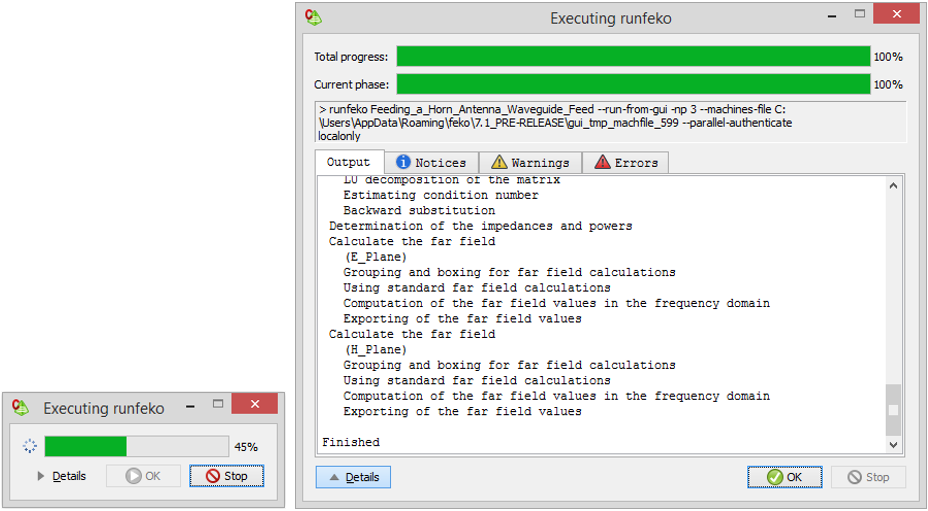Running the Sequential Version
Run the sequential version of Feko with optional parameters.
It is recommended to run the Feko kernel directly from the GUI components CADFEKO, EDITFEKO or POSTFEKO. Once a session or model has been loaded, the sequential Feko solver can be started from the Solve/Run tab, by selecting Feko (the shortcut key Alt+4 can also be used).
While the Feko kernel is running, the status of the calculation phases is indicated on the Executing runfeko dialog, see Figure 1. The output generated by the Feko kernel is hidden by default. The Feko kernel output may be viewed by clicking on the Details button and selecting the Output tab. Similarly, notices, warnings and errors can be viewed by selecting the Notices, Warnings and Errors tabs respectively.

Figure 1. The Executing runfeko dialogs. Output generated by the kernel is hidden by default. Solver output may be viewed by clicking on the Details button.
runfeko example08where example08 must be a valid Feko input file (either .cfx or .pre/.cfm or .fek etc., there are internal time checks to run cadfeko_batch and/or PREFEKO as required to generate missing files or replace older ones).
RUNFEKO accepts the optional parameters listed below. More information regarding additional options for launching and controlling the parallel version of the solver can be found in Running the Parallel Version. Additional options for the remote launching of Feko are found in Running on a Remote Host.
In CADFEKO these settings are available by selecting the Solve/Run tab and clicking on the dialog launcher button on the Run/launch group. For POSTFEKO, select the Home tab and click on the dialog launcher button on the Run/launch group.
- --version
- Print the version information and then exit.
- --priority x
- The value x specifies the CPU usage priority of the Feko run:
- --use-gpu
- [NUM_GPUS][:GPU_1[,GPU_N]] Execute Feko using GPU acceleration. The optional parameters are:
- --remote-use-mpi
- Activates the MPI method on Windows.
- --execute-cadfeko_batch
- Always execute CADFEKO_BATCH first (by-pass automatic checks based on file existence and date stamps.)
- --no--execute-cadfeko_batch
- CADFEKO_BATCH will not be run to create a new .cfm and .pre file.
- --execute-prefeko
- Always execute PREFEKO even if the existing .fek file is newer than the .pre.
- --no--execute-prefeko
- PREFEKO will not be run to generate a new .fek file before the Feko solver is launched, even if the .fek and/or .cfm files are older than the existing .fek file.
- --use-job-scheduler
- Run the parallel Feko kernel within a queuing
system and obtain the number of parallel processes as well as the host list
directly from the respective job scheduler.Note:The Intel MPI library supports the following job schedulers:
- Microsoft Windows
-
- Altair PBS Professional
- Microsoft HPC Pack
- Linux
-
- Altair PBS Professional
- Torque
- OpenPBS
- IBM Platform LSF
- Parallelnavi NQS
- SLURM
- Univa Grid Engine
- -d
- Debug mode with extra output (can be used to troubleshoot errors).
- --prefeko-options
- All options following, up to the next –xxx-options, are passed to PREFEKO.
- --feko-options
- All options following, up to the next –xxx-options, are passed to Feko.
- --adaptfeko-options
- All options following, up to the next –xxx-options, are passed to ADAPTFEKO.
The optional command line parameters for Feko (specified
after --feko-options) are listed below.
- --check-only
- Feko processes and checks the model, but does not start a solution. This is useful to, for example, check an input file on a local computer before submitting it to a cluster.
- --estimate-resource-requirements-only
- Feko processes the model and provides an
estimate for the memory consumption. The estimated value is provided at the
end of the .out file.Note: An estimate is only available for:
- MoM
- MLFMM
- PO (not hybridised with any other solution methods).
Tip: For a more accurate estimate, run the estimation with the intended number of processes on the intended host(s). - -e ENV=value
- This has the same effect as starting Feko with
the environment variable ENV set to value. More than
one
-e …argument is allowed. - --data-export-format n
- Use the nth version format for the data export files
(.efe, hfe,
.ffe, .os,
.ol). Allowed values for n are
1and2where2is the latest version (since Feko 6.1). If not specified, the default is to use the latest supported version. - --mtl-circuit-export
- Special execution mode to export SPICE MTL circuit files.